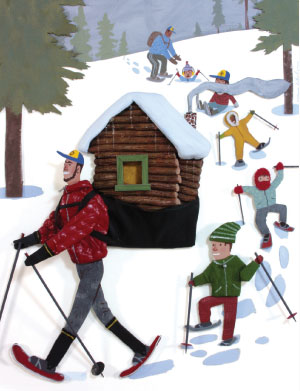
Brrrr-illiant
Hot tips for cold-weather fun.
Illustration by Dave Wheeler
When you think of Cub Scout camping, “Wisconsin in January” may not come to mind. Still, check out one of Samoset Council’s most popular events: the Polar Cubs program.
 Even though temperatures tend to run in the teens up there at that time of year, Cub Scouts and their families turn out in warmly dressed droves for a series of weekend events in January and February at the state’s Hanna Winter Resort.
Even though temperatures tend to run in the teens up there at that time of year, Cub Scouts and their families turn out in warmly dressed droves for a series of weekend events in January and February at the state’s Hanna Winter Resort.
“About one-third of our units show up for this,” says Scott Domino, Samoset’s camping director. “And we get a number of out-of-council attendees, too.”
At the event, staff members group Cub Scouts into “super dens” to keep those from the same pack together. Super dens rotate through various activities such as sledding, tubing, snowshoeing, broomball, and a really cool one that involves flinging tennis balls at snowmen with a slingshot. Then, at night, campers return to heated cabins to defrost, watch a movie, and sleep in warm beds.
“The adults like it because they don’t have to plan anything—just show up,” Domino says. “The kids love it because it’s fun.”
Tim Tocket, a Scouter in Pen Argyl, Pa., always thought the BSA had a rule forbidding Cub Scouts from camping when temperatures dipped below 32 degrees. Not so. The “Age-Appropriate Guidelines for Scouting Activities” states that only Boy Scouts, Varsity Scouts, and Venturers may participate in winter camping. But the addition of heated cabins (when you follow appropriate Youth Protection guidelines) can make winter activities with overnight stays suitable for Cub Scouts. With cabins available, a boy who gets too wet, too cold, or too tired can head inside.
Tocket, an Eagle Scout who prefers to take his pack on camping trips every month, plans to keep on camping year-round. He’s learned ways to make winter camping work for younger boys. Tocket plans plenty of hiking, games, and activities for winter outings to keep his campers active. “As long as they’re moving,” he says, “they stay warm.”
Other tips for Cub Scout camping in cold weather:
- Give plenty of packing guidelines to parents and adult leaders and stress layering for warmth. Domino distributes a handbook with detailed information to unit leaders before the Polar Cubs weekends. And because many Cub Scout parents won’t know how to prepare for outdoor winter activities, Tocket distributes packing lists.
- Pack extra items of everything warm. Domino suggests bringing a stash of extra hats and mittens for Cub Scouts whose gear gets wet, lost, or forgotten. Tocket tells the kids to bring extra blankets, hats, gloves, and footwear.
- Remember hydration. Campers need plenty of fluids, even in the cold.
- Offer plenty of hearty food, and keep meal preparation simple.
- Cancel or postpone if the forecast calls for heavy snow or extremely low temperatures.
Bottom line: Keep it simple, and make it fun. A well-planned cabin camping experience can provide a fun, safe venue where Cub Scouts can warm to the outdoors—even when it’s cold out.